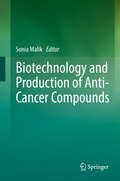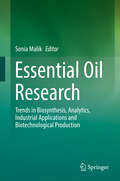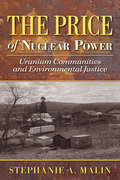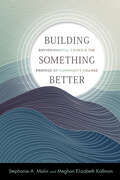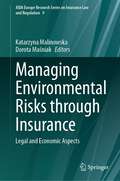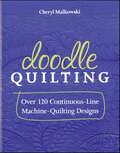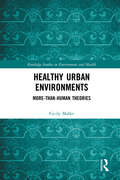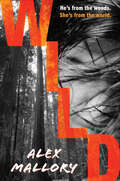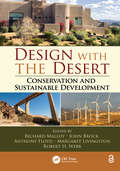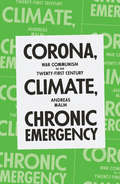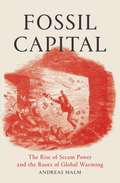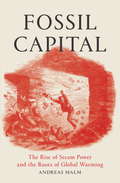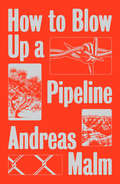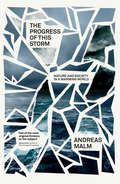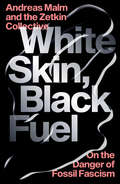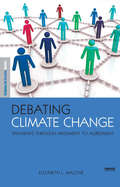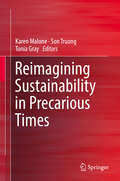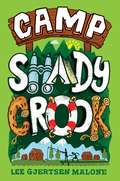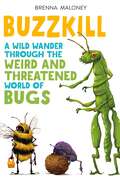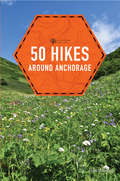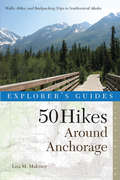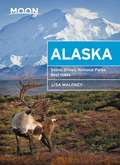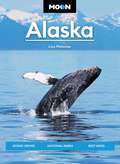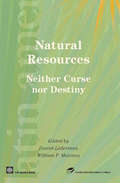- Table View
- List View
Biotechnology and Production of Anti-Cancer Compounds
by Sonia MalikThis book discusses cancers and the resurgence of public interest in plant-based and herbal drugs. It also describes ways of obtaining anti-cancer drugs from plants and improving their production using biotechnological techniques. It presents methods such as cell culture, shoot and root culture, hairy root culture, purification of plant raw materials, genetic engineering, optimization of culture conditions as well as metabolic engineering with examples of successes like taxol, shikonin, ingenol mebutate and podophylotoxin. In addition, it describes the applications and limitations of large-scale production of anti-cancer compounds using biotechnological means. Lastly, it discusses future economical and eco-friendly strategies for obtaining anti-cancer compounds using biotechnology.
Essential Oil Research: Trends in Biosynthesis, Analytics, Industrial Applications and Biotechnological Production
by Sonia MalikThis book highlights the advances in essential oil research, from the plant physiology perspective to large-scale production, including bioanalytical methods and industrial applications. The book is divided into 4 sections. The first one is focused on essential oil composition and why plants produce these compounds that have been used by humans since ancient times. Part 2 presents an update on the use of essential oils in various areas, including food and pharma industries as well as agriculture. In part 3 readers will find new trends in bioanalytical methods. Lastly, part 4 presents a number of approaches to increase essential oil production, such as in vitro and hairy root culture, metabolic engineering and biotechnology. Altogether, this volume offers a comprehensive look at what researchers have been doing over the last years to better understand these compounds and how to explore them for the benefit of the society.
The Price of Nuclear Power
by Stephanie A. MalinRising fossil fuel prices and concerns about greenhouse gas emissions are fostering a nuclear power renaissance and a revitalized uranium mining industry across the American West. In The Price of Nuclear Power, environmental sociologist Stephanie Malin offers an on-the-ground portrait of several uranium communities caught between the harmful legacy of previous mining booms and the potential promise of new economic development. Using this context, she examines how shifting notions of environmental justice inspire divergent views about nuclear power's sustainability and equally divisive forms of social activism. Drawing on extensive fieldwork conducted in rural isolated towns such as Monticello, Utah, and Nucla and Naturita, Colorado, as well as in upscale communities like Telluride, Colorado, and incorporating interviews with community leaders, environmental activists, radiation regulators, and mining executives, Malin uncovers a fundamental paradox of the nuclear renaissance: the communities most hurt by uranium's legacy--such as high rates of cancers, respiratory ailments, and reproductive disorders--were actually quick to support industry renewal. She shows that many impoverished communities support mining not only because of the employment opportunities, but also out of a personal identification with uranium, a sense of patriotism, and new notions of environmentalism. But other communities, such as Telluride, have become sites of resistance, skeptical of industry and government promises of safe mining, fearing that regulatory enforcement won't be strong enough. Indeed, Malin shows that the nuclear renaissance has exacerbated social divisions across the Colorado Plateau, threatening social cohesion. Malin further illustrates ways in which renewed uranium production is not a socially sustainable form of energy development for rural communities, as it is utterly dependent on unstable global markets. The Price of Nuclear Power is an insightful portrait of the local impact of the nuclear renaissance and the social and environmental tensions inherent in the rebirth of uranium mining.
Building Something Better: Environmental Crises and the Promise of Community Change (Nature, Society, and Culture)
by Stephanie A. Malin Meghan Elizabeth KallmanAs the turmoil of interlinked crises unfolds across the world—from climate change to growing inequality to the rise of authoritarian governments—social scientists examine what is happening and why. Can communities devise alternatives to the systems that are doing so much harm to the planet and people? Sociologists Stephanie A. Malin and Meghan Elizbeth Kallman offer a clear, accessible volume that demonstrates the ways that communities adapt in the face of crises and explains that sociology can help us understand how and why they do this challenging work. Tackling neoliberalism head-on, these communities are making big changes by crafting distributive and regenerative systems that depart from capitalist approaches. The vivid case studies presented range from activist water protectors to hemp farmers to renewable energy cooperatives led by Indigenous peoples and nations. Alongside these studies, Malin and Kallman present incisive critiques of colonialism, extractive capitalism, and neoliberalism, while demonstrating how sociology’s own disciplinary traditions have been complicit with those ideologies—and must expand beyond them. Showing that it is possible to challenge social inequality and environmental degradation by refusing to continue business-as-usual, Building Something Better offers both a call to action and a dose of hope in a time of crises.
Managing Environmental Risks through Insurance: Legal and Economic Aspects (AIDA Europe Research Series on Insurance Law and Regulation #9)
by Katarzyna Malinowska Dorota MaśniakThis book identifies the role of insurance in a comprehensive system for managing environmental risks at the local, regional and global level. National and international legal instruments regulating environmental protection, especially aspects like pollution, are not precisely reflected in insurance concepts intended to cover environmental risks. As such, there is a need to identify environmental risks and to propose a taxonomy of environmental risks for various types of insurance coverage. The authors refer to the issues of liability in environmental protection, the scope of insurance coverage and comment on specific issues the importance of which has been noticed by the legislator or insurance practice. The book examines these issues horizontally and vertically from various standpoints, focusing on insurance as a means of managing environmental risks. In this regard, it mainly concentrates on (1) identifying and analyzing environmental risks and methods for managing them via private and public instruments, and (2) insuring these risks. The book is intended for all those interested in the field of insurance and environmental risk regimes, including lawyers, academics and legal professionals.
Doodle Quilting: Over 120 Continuous-Line Machine-Quilting Designs
by Cheryl MalkowskiLearn to draw...with your sewing machine! In this beginner's guide to free-motion, continuous-line quilting designs, the focus is on selecting the right forms and lines that get you where you need to go...because sometimes the hardest part is figuring out where to quilt next! You'll gain confidence in your innate artistic ability to draw basic shapes, then you'll learn how to put them together into over a hundred different all-over quilting designs. • See how easy it can be to create interesting quilting designs by mastering your doodling skills • From squiggles and swirls to flowers and feathers, learn which shapes are best for confined spaces and which work better traveling across your quilt • Includes drawing exercises and tips for transferring your designs from paper to fabric
Healthy Urban Environments: More-than-Human Theories (Routledge Studies in Environment and Health)
by Cecily MallerSet in the ‘human–environment’ interaction space, this book applies new theoretical and practical insights to understanding what makes healthy urban environments. It stems from recognition that the world is rapidly urbanising and the international concern with how to create healthy settings and liveable cities in the context of a rapidly changing planet. A key argument is that usual attempts to make healthy cities are limited by human-centrism and bifurcated, western thinking about cities, health and nature. Drawing on the innovative ‘more-than-human’ scholarship from a range of disciplines, it presents a synthesis of the main contributions, and how they can be used to rethink what healthy urban environments are, and who they are for. In particular, the book turns its attention to urban biodiversity and the many non-human species that live in, make and share cities with humans. The book will be of interest to scholars and students in human geography, health sociology, environmental humanities, public health, health promotion, planning and urban design, as well as policymakers and professionals working in these fields.
Wild
by Alex MalloryCade, a teen raised alone in the wilderness, is thrust into civilization in this modern retelling of Tarzan.No one knows the forest better than Cade, who has spent his entire life there, foraging, hunting, and surviving. Raised to believe no one else is left in the world, he is shocked when he encounters Dara, a modern girl on a camping trip in his woods. And when an accident forces him back into society with her, he begins to question his entire life. Together, Cade and Dara attempt to handle their newfound celebrity as the media closes in. But the truth of Cade's past might be too much for either of them.Alex Mallory's action-packed and romantic tale is told from both Cade's and Dara's point of view and is perfect for fans of contemporary and dystopian YA as well as classic survival stories such as Hatchet, Lord of the Flies, and Tarzan.
Design with the Desert: Conservation and Sustainable Development
by Richard MalloyTypical development in the American Southwest often resulted in scraping the desert lands of the ancient living landscape, to be replaced with one that is human-made and dependent on a large consumption of energy and natural resources. This transdisciplinary book explores the natural and built environment of this desert region and introduces development tools for shaping its future in a more sustainable way. It offers valuable insights to help promote ecological balance between nature and the built environment in the American Southwest-and in other ecologically fragile regions around the world.
Corona, Climate, Chronic Emergency: War Communism in the Twenty-First Century
by Andreas MalmWhat does the COVID 19 tell us about the climate breakdown, and what should we do about it?The economic and social impact of the coronavirus pandemic has been unprecedented. Governments have spoken of being at war and find themselves forced to seek new powers in order to maintain social order and prevent the spread of the virus. This is often exercised with the notion that we will return to normal as soon as we can. What if that is not possible? Secondly, if the state can mobilize itself in the face of an invisible foe like this pandemic, it should also be able to confront visible dangers such as climate destruction with equal force. In Corona, Climate, Chronic Emergency, leading environmental thinker, Andreas Malm demands that this war-footing state should be applied on a permanent basis to the ongoing climate front line. He offers proposals on how the climate movement should use this present emergency to make that case. There can be no excuse for inaction any longer.
Fossil Capital: The Rise of Steam Power and the Roots of Global Warming
by Andreas MalmHow capitalism first promoted fossil fuels with the rise of steam power The more we know about the catastrophic implications of climate change, the more fossil fuels we burn. How did we end up in this mess?
Fossil Capital: The Rise of Steam Power and the Roots of Global Warming
by Andreas MalmHow capitalism first promoted fossil fuels with the rise of steam powerThe more we know about the catastrophic implications of climate change, the more fossil fuels we burn. How did we end up in this mess? In this masterful new history, Andreas Malm claims it all began in Britain with the rise of steam power. But why did manufacturers turn from traditional sources of power, notably water mills, to an engine fired by coal? Contrary to established views, steam offered neither cheaper nor more abundant energy--but rather superior control of subordinate labour. Animated by fossil fuels, capital could concentrate production at the most profitable sites and during the most convenient hours, as it continues to do today. Sweeping from nineteenth-century Manchester to the emissions explosion in China, from the original triumph of coal to the stalled shift to renewables, this study hones in on the burning heart of capital and demonstrates, in unprecedented depth, that turning down the heat will mean a radical overthrow of the current economic order.From the Trade Paperback edition.
How to Blow Up a Pipeline
by Andreas MalmProperty will cost us the earthThe science on climate change has been clear for a very long time now. Yet despite decades of appeals, mass street protests, petition campaigns, and peaceful demonstrations, we are still facing a booming fossil fuel industry, rising seas, rising emission levels, and a rising temperature. With the stakes so high, why haven't we moved beyond peaceful protest?In this lyrical manifesto, noted climate scholar (and saboteur of SUV tires and coal mines) Andreas Malm makes an impassioned call for the climate movement to escalate its tactics in the face of ecological collapse. We need, he argues, to force fossil fuel extraction to stop--with our actions, with our bodies, and by defusing and destroying its tools. We need, in short, to start blowing up some oil pipelines.Offering a counter-history of how mass popular change has occurred, from the democratic revolutions overthrowing dictators to the movement against apartheid and for women's suffrage, Malm argues that the strategic acceptance of property destruction and violence has been the only route for revolutionary change. In a braided narrative that moves from the forests of Germany and the streets of London to the deserts of Iraq, Malm offers us an incisive discussion of the politics and ethics of pacifism and violence, democracy and social change, strategy and tactics, and a movement compelled by both the heart and the mind. Here is how we fight in a world on fire.
The Progress of This Storm: Nature and Society in a Warming World
by Andreas MalmAn attack on the idea that nature and society are impossible to distinguish from each otherIn a world careening towards climate chaos, nature is dead. It can no longer be separated from society. Everything is a blur of hybrids, where humans possess no exceptional agency to set them apart from dead matter. But is it really so? In this blistering polemic and theoretical manifesto, Andreas Malm develops a counterargument: in a warming world, nature comes roaring back, and it is more important than ever to distinguish between the natural and the social. Only with a unique agency attributed to humans can resistance become conceivable.
White Skin, Black Fuel: On the Danger of Fossil Fascism
by Andreas Malm The Zetkin CollectiveRising temperatures and the rise of the far right. What disasters happen when they meet?In the first study of the far right&’s role in the climate crisis, White Skin, Black Fuel presents an eye-opening sweep of a novel political constellation, revealing its deep historical roots. Fossil-fuelled technologies were born steeped in racism. No one loved them more passionately than the classical fascists. Now right-wing forces have risen to the surface, some professing to have the solution—closing borders to save the nation as the climate breaks down. Epic and riveting, White Skin, Black Fuel traces a future of political fronts that can only heat up.
Very Unusual Plants (Fountas & Pinnell Classroom, Guided Reading Grade 2)
by Charlotte MaloneNIMAC-sourced textbook
Debating Climate Change: Pathways through Argument to Agreement (The\earthscan Science In Society Ser.)
by Elizabeth L MaloneAs greenhouse gas emissions continue unabated and contentious voices fill the air, the question gains urgency: How can people with widely varying viewpoints agree to address climate change? Each participant in the debate seems to have a different agenda, from protecting economic growth in developing countries to protecting the energy industry in industrialized countries, from those aghast at the damage done to the Earth to optimists who think we just need to adjust our technological approach. Debating Climate Change sorts through the tangle of arguments surrounding climate change to find paths to unexpected sites of agreement. Using an innovative sociological approach - combined discourse and social network analyses - Elizabeth L. Malone analyzes 100 documents representing a range of players in this high-stakes debate. Through this she shows how even the most implacable adversaries can find common ground - and how this common ground can be used to build agreement. Written in a clear, accessible style, this original research and insightful use of communication analysis will help advance understanding and negotiation on climate change throughout the pivotal times to come. Published with Science in Society
Reimagining Sustainability in Precarious Times
by Karen Malone Son Truong Tonia GrayThis book reflects the considerable appeal of the Anthropocene and the way it stimulates new discussions and ideas for reimagining sustainability and its place in education in these precarious times. The authors explore these new imaginings for sustainability using varying theoretical perspectives in order to consider innovative ways of engaging with concepts that are now influencing the field of sustainability and education. Through their theoretical analysis, research and field work, the authors explore novel approaches to designing sustainability and sustainability education. These approaches, although diverse in focus, all highlight the complex interdependencies of the human and more-than-human world, and by unpacking binaries such as human/nature, nature/culture, subject/object and de-centring the human expose the complexities of an entangled human-nature relation that are shaping our understanding of sustainability. These messy relations challenge the well-versed mantras of anthropocentric exceptionalism in sustainability and sustainability education and offer new questions rather than answers for researchers, educators, and practitioners to explore. As working with new theoretical lenses is not always easy, this book also highlights the authors' methods for approaching these ideas and imaginings.
Camp Shady Crook
by Lee Gjertsen MaloneIt’s Ocean’s Eleven set in a summer camp as two kids try to one-up each other in a con competition at a camp that isn’t quite what it seems… <P><P>For Archie, the start of summer means another stint at Camp Shady Brook, where there is a lot more to the camp than meets the eye—just like Archie and his now blended family. But thanks to a con Archie developed last year, he’s finally somebody…and he’s not going to lose that status to the new girl, Vivian. <P><P> For Vivian, thanks to an incident That Shall Not Be Named or Spoken Of, her summer of exotic travels with Mom and Dad has turned into traveling to a dump of a summer camp in the middle of nowhere. But thanks to perfect timing, Vivian soon finds herself in a ring of kids trying to out-con each other—and discovers Camp Shady Brook is more like Camp Shady Crook. And when one final, massive con could cost Vivian the first friends she’s had in a while, can she and Archie figure out a way to make things right?
Buzzkill: A Wild Wander Through the Weird and Threatened World of Bugs
by Brenna MaloneyThe praying mantis is the only animal on Earth with one ear—and it’s in the middle of its chest. Aphids are born pregnant. Moths can’t fly during an earthquake. If you didn’t know these things, you soon will. Packed full of jaw-dropping facts, Buzzkill presents the big picture on bugs. You might think ew, gross. Insects are icky. Or scary. Or dangerous. They can be. But there’s so much more you need to know.Insects play a critical role on our planet, from sustenance to pollination to medicines and more. Brenna Maloney tackles both the wacky and weird, as well as threats to insects and their habitats, their possible extinction, and ways that everyday people, like you, can prevent their decline.Find out what all the buzz is about!Godwin BooksA JUNIOR LIBRARY GUILD GOLD STANDARD TITLE
50 Hikes around Anchorage (Explorer's 50 Hikes #0)
by Lisa MaloneyA hiker’s companion to the best treks within striking distance of Alaska’s largest city
Explorer's Guide 50 Hikes Around Anchorage (Explorer's 50 Hikes)
by Lisa MaloneyThe best hikes in--and beyond--the web of trails that covers the Anchorage area, from well-known treks to little-know gems. 50 Hikes Around Anchorage is your guide to exploring everything in this hub of cultural and outdoor life, from never-before-published wilderness routes to miles of mountain footpaths and National Recreation Trails. All hikes are within a 30-minute drive of the city and include such sites as the Iditarod Trail, Campbell Tract, Rendezvous Peak, Mount Baldy, and so much more. Routes pass over foothills and alongside streams, showcasing the region's natural beauty and pristine wilderness areas. You'll find cultural and natural history on each of the routes, detailed directions to the trailheads, GPS coordinates, topographic maps, information on local rules and regulations, and details on Leave No Trace ethics.
Moon Alaska: Scenic Drives, National Parks, Best Hikes (Travel Guide)
by Lisa MaloneyRemote, wild, and all-around otherworldly, Alaska promises unforgettable adventure. Discover the heart of "The Last Frontier" with Moon Alaska. Inside you'll find:Strategic itineraries, whether you have a week to hit the top sights or a month to explore the whole state, with ideas for outdoor adventurers, history buffs, road-trippers, wildlife enthusiasts, and moreThe top outdoor activities: Embark on a glacier hike, cast your line in the halibut capital of the world, or take an intrepid "flightseeing" tour to secluded glacier landings in Denali National Park. Experience the thrill of spotting wild bears, moose, wolves, or even a walrus, or hop on a boat at Columbia Glacier to watch sea otters, harbor seals, and whales glide through the water. Kayak on tranquil sounds and secluded lakes or camp under a crystal-clear sky full of starsUnique experiences: Learn about Alaska's native cultures, visit quirky small towns, and discover the best spots to witness the enchanting northern lightsHonest advice from Anchorage local and outdoor aficionado Lisa Maloney on when to go, what to pack, and where to stay, from campsites and hostels to B&Bs and resort fishing lodgesFull-color photos and detailed maps throughout, plus a full-color foldout mapHow to get there and get around by plane, train, ferry, cruise ship, or guided tourRecommendations for families, LGBTQ+ travelers, women traveling solo, seniors, international visitors, and travelers with disabilitiesThorough background on the culture, weather, wildlife, local laws, and history, plus tips for health and safetyWith Moon Alaska's practical tips and expert insight, you can find your adventure.Can't get enough of Alaska? Try Moon Anchorage, Denali & the Kenai Peninsula. Headed to Canada? Try Moon Vancouver & Canadian Rockies Road Trip or Moon Banff National Park.
Moon Alaska: Scenic Drives, National Parks, Best Hikes (Travel Guide)
by Lisa MaloneyRemote, wild, and all-around otherworldly, Alaska promises unforgettable adventure. Discover the heart of "The Last Frontier" with Moon Alaska. Inside you'll find:Strategic itineraries, whether you have a week to hit the top sights or a month to explore the whole state, with ideas for outdoor adventurers, history buffs, road-trippers, wildlife enthusiasts, and more The top outdoor activities: Embark on a glacier hike, cast your line in the halibut capital of the world, or take an intrepid "flightseeing" tour to secluded glacier landings in Denali National Park. Experience the thrill of spotting wild bears, moose, wolves, or even a walrus, or hop on a boat at Columbia Glacier to watch sea otters, harbor seals, and whales glide through the water. Kayak on tranquil lakes or camp under a crystal-clear sky full of stars Unique experiences: Learn about Alaska's native cultures, visit quirky small towns, and discover the best spots to witness the enchanting northern lights Honest advice from Anchorage local and outdoor aficionado Lisa Maloney on when to go, what to pack, and where to stay, from campsites and hostels to B&Bs and resort fishing lodges Full-color photos and detailed maps throughout, plus a full-color foldout mapHow to get there and get around by plane, train, ferry, cruise ship, or guided tour Thorough background on the culture, weather, wildlife, and history, plus health and safety tips With Moon Alaska's practical tips and expert insight, you can find your adventure. Headed to Canada? Try Moon Vancouver & Canadian Rockies Road Trip or Moon Banff National Park. About Moon Travel Guides: Moon was founded in 1973 to empower independent, active, and conscious travel. We prioritize local businesses, outdoor recreation, and traveling strategically and sustainably. Moon Travel Guides are written by local, expert authors with great stories to tell—and they can't wait to share their favorite places with you. For more inspiration, follow @moonguides on social media.
Natural Resources: Neither Curse nor Destiny
by William F. Maloney Daniel Lederman'Natural Resources: Neither Course nor Destiny' brings together a variety of analytical perspectives, ranging from econometric analyses of economic growth to historical studies of successful development experiences in countries with abundant natural resources. The evidence suggests that natural resources are neither a curse nor destiny. Natural resources can actually spur economic development when combined with the accumulation of knowledge for economic innovation. Furthermore, natural resource abundance need not be the only determinant of the structure of trade in developing countries. In fact, the accumulation of knowledge, infrastructure, and the quality of governance all seem to determine not only what countries produce and export, but also how firms and workers produce any good.
